Mobile Analytics And Everything You Need To Know
Mục Lục
One of the reasons that many marketers are reluctant to spend more money on the mobile segment while users spend a huge time on mobile devices is about measuring ad performance on mobile devices (mobile analytics), which is still challenging. However, this does not mean that mobile analytics is not possible but simply because this is a very new field and still limited to be fully understood. This article is quite long but written with the hope to give readers a thorough and clear look on the mobile application ecosystem, what mobile analytics is, what it includes, how it works and what are the difficulties and challenges as well as the future of this field.
The victory of mobile devices
Before moving into mobile analytics, many of you will ask yourselves why we need to pay attention to this field. The only answer is that mobile has won and you have to follow the orientation of mobile or you will be left behind (go mobile or die).
We’ve heard a lot about how mobile devices such as smartphones / tablets will eventually replace laptops / desktops in the future. That the replacement will happen or not can not be forespoken, but the fact that these devices dominate and become the trend of the future is no longer controversial. Former Google CEO Eric Schmidt once said: “The trend has been that mobile is winning. It is now won “. This statement is perfectly valid if we look at some data and number:
1. The number of mobile users surpassed desktop users: 2014 marks the time when the number of people using mobile devices for the first time exceeded the number of desktop users.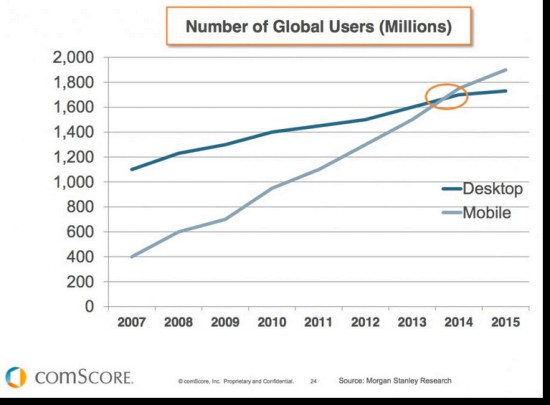 Number of mobile users vs desktop users. Source: comScore
Number of mobile users vs desktop users. Source: comScore
2. The time users spend on mobile devices is more than the time people use desktop computers. It is interesting, however, that if you look at the total usage time, you will see it increased dramatically from 2.7 hours per day in 2008 to 5.6 hours per day in 2015. The time that people spend for mobile devices has increased 10 times while the time of computer use has decreased but not much.
Time spent on devices- Source: KPCB
3. The number of mobile searches have surpassed the number of searches on the desktop. Google has officially announced that searches for mobile users have exceeded the number of searches of desktop users. This shows that people are getting used to finding instant information right on their mobile phones / tablets.
Mobile search surpassed desktop – Source: ComScore
4. Of the total number of times people use mobile devices, 90% of them will be for apps (Facebook, games, OTT, etc.), and only about 10% are for surfing the web through the browser (such as Safari, Chrome, Firefox, Android browser, etc.).
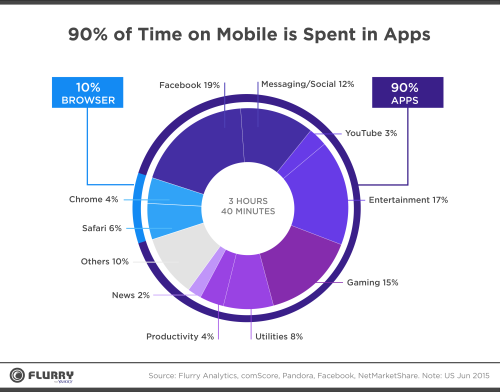
90% of the time the user uses the phone is on the application, only 10% is on the browser. Source: Analytics Flurry
5. The cost of advertising for mobile is escalating fast and has outweighed the cost of advertising for the desktop. What noticeable is that not only in the amount of money being spent in this field, but also the potential for advertising this segment will continue to advance in the future as users is risingly spending more time on this device.
The amount of money for advertising on the mobile segment is not commensurate with the time they spend on this channel. Source: KPCB
From the information above we can draw some conclusions that: with the increase in the number of users and the time spent on mobile (1 & 2) and with the user not relying more on mobile devices for information seeking outside (3), mobile will be the important bridge between the brand and potential customers. Finally, with the rate of 80% of the time that user spend on using apps (4), it’s clear that investing in mobile analytics is very important.
How does mobile web analytics work?
When a user wants to access a website, they need to access through a device (desktop, laptop, tablet, mobile, etc.) and on this device they open a web browser (Firefox, Chrome, Internet Explorer , safari, etc …) and then type the address of the site they want to visit. As soon as they hit enter, the following things will happen:
![]()
- The browser will have to provide some information for the website and the information may include: the IP address, information about the accessing device, the browser information, where the user is before they come to the website, when the access is made, whether the user is new or the returning user, whether the accessing is successful, etc. All of this information can be recorded by the website and stay logged in the server. This information is generally referred to as the HTTP Request.
- For the user, as soon as they visit the website, their device will be placed a file called cookies, which contains information such as encrypted login information, which page they access, which information they read, whether they are logged in, how long they stay on the website, etc. Cookies are stored on the user’s browser for the purpose of providing a better experience when they return to the website. For example, you do not need to log in again, the page will load faster, etc. Cookies are also used very commonly to collect customer information for advertising by the owner of the website (1st party cookies) or by an advertising angency (third party cookies). (*)
(*) Differentiate 1st party cookies vs. 3rd party cookies: For example, if you go to the conversion.vn website and the stored cookíe domain is conversion.vn, this is the 1st party cookies from the website you are visiting. But if you go to the conversion.vn website but have cookies from another domain such as abc.com then it is 3rd party cookies. 3rd party cookies are also known as advertising cookies because they can track user behavior, which websites they visit, online habits (because 3rd party cookies are installed on more sites, not just 1 as the 1s. party cookies). Nowadays, it is very popular with advertising networks as a way to target audience more accurately.
- Measurement tools like Google Analytics will require users to add a tracking code to every page on the website they want to measure. These code will actually gather information from HTTP Request (1) and cookies (2) and other information from the browser / system. All of that information will now be packaged and sent to the Google Analytics server.
[Image 2: How Websites Recognize Information When Users Access Through Web Server Logs And Cookies]
- Once the information is sent to the Google Analytics server, it will be associated with other data that Google owns (collected when users use other Google services such as Gmail, Google Map, Google Translate, Android, etc. Do you want to know how many Google products are around you? See here) or Google purchased data from a 3rd party. (Google will buy the information about your location through via IPs from internet service providers). Google’s system will combine all of these data sources, eliminate duplication, and provide meaningful analytical information. Not all of this analytical information will be shared with you, only part of it will go through the next step.
- A part of the processed data as described in the previous step will be included in the user’s Google Analytics account database and then applied to the filters and settings that the user chooses for that account. The data is then arranged and displayed on the dashboard of your Google Analytics account, which is what you usually see. Now you probably understand where information like demographics, interests, geographics, behavior, technology, and so on come from on Google Analytics?
However, with mobile analytics, things will get more complicated as the mobile web faces different challenges from the desktop ones:
- Cookies or the 3rd party cookies are by default blocked in the Safari browser of iOS and with this browser currently occupies more than 60% of the market, this is definitely a huge problem.

Safari defaultly block 3rd party cookies, though it accounts for the majority of the market share. Source: comscore
- Most mobile apps will not send HTML referers when users click on links to access the website, which is similar to links in word or pdf files, simply because they are not the same type. This issue has also been addressed in the article of Google Analytics and why it is inaccurate. With up to 80% of the time that users use the mobile app, this is a big challenge for mobile analytics.
Getting familiar with mobile app analytics
The mobile app and the mobile web are basically the same but also different. For websites, we need to measure traffic (click / visit / session) and user interaction on the website (pageviews, time onsite) while with the mobile app, we measure the number of installs (install) and phone interactions (screen view, time on screen). Before going further, you need to understand two basic definitions related to the install metrix of mobile:
Organic install: These are app installs that come from when users search for them by keyword or brand name or while viewing a list of top apps on the app store. You can think of this as the organic traffic of the website.
Non-organic install: These are app installs that come from promotional campaigns outside the app store through promotional channels or the app users installing it after being encouraged to with get some benefits (virtual currency, in-game items, etc.). You can see this as paid traffic on the website.
With organic install, the main method is still based on the App Store Optimization (ASO) to put the application on the top of the search results. ASO is based on a number of different factors to rank an application, but overall it will include: title, keywords, number of downloads, ratings, reviews, screenshots, icons, etc (we’ll have a post discussing about this topic later)
ASO is important in increasing the application’s organic installs. Source: businessofapps
The non-organic install is based on the advertising costs to increase the number of downloads, increase sales, and improve the ROI of the app. Since the number of downloads is an important part of the ASO, the non-organic install plays a very important role in supporting the organic install.
Ads can help increase your installs and thereby enhance the performance of your ASO
Mobile app ecosystem
Understanding the mobile app ecosystem is essential if you want to know how mobile analytics works. Below is the mobile app ecosystem model:
The ecosystem of mobile applications. Source: conversion.vn
Buy Side is the side who needs to buy advertising lile brands, agencies, application developers, and DSP (Demand Side Platforms – which makes buying ads more effective).
Sell Side is the publishers wishing to sell advertising. Supply Side Platform (SSP – help making selling advertising more effectively)
In the middle, Ad Network and Ad Exchange serve as intermediate channels that connect both sellers and buyers together.
Finally, we have mobile analytics tools to help measure and evaluate the effectiveness of the mobile advertising ecosystem. In the next section we will discuss about the types of analytics tools above.
Mobile app analytics tools
The mobile app analytics tools are divided into three main categories: App Store Analytics, Attribution Analytics, and In-app Analytics. Each type has its own functions and serves different purposes.
The mobile analytics tools are divided into three main functions with smaller branches. Source: conversion.vn
App Store Analytics
These are measurement applications that will show viewers information about the number of downloads, app rankings on the appstore, downloading devices, geographic location, and application revenue. App store analytics is divided into two branches:
App Stores: App stores like iTunes, Google Play also provide the above basic data for the app developer. They have an advantage of providing necessary information for the user to understand and because this is the data from the app store, it will have the highest level of accuracy. The downside is that only your own application’s data can be viewed.
Providers: Some vendors like AppAnnie and AppFigures offer data app stores at a more upgraded level with some features that information that app stores do not normally have. Their advantage is that you can see data from competitors or other applications that can filter and shred data for further studies by industry or detailed analysis. The main drawback is that not all data is from the source, so the accuracy will depend on the application.
Attribution Analytics
These are tools that allow users to measure traffic to the application and to allocate the traffic into the appropriate sources. These applications can be considered as the Google Analytics of the mobile app world. These tools can be split into two branches:
Integrated: This is actually the measurement solution provided by the companies that provide mobile advertising services. Advantages: Simplifying things, lessening the process of using a variety of measurement tools, and for busy marketers this is a good solution to consider. The downside: for these services, they at the same time sell advertisement, optimize and provide measurement services. The purpose of these services is to sell more ads and earn profit, analytics are part of the service, so it’s not something that these services will invest heavily in, so the lack of updates or Upgrades are rather common. In addition, because the purpose of these services is to profit from advertising, sometimes their measurement may be biased for their traffic sources.
iTunes, Google Play: These are specialized services that provide measurement solutions that we call third-party. Advantages: They are not advertising services and their goal is to provide the most accurate mobile analytic service so there will be no conflict of interest here. Users would feel assured about the truthfulness of the measurement. Disadvantage: additional steps in the measurement process and reconcile data of advertising campaigns. But this is a necessary thing to do if the advertising campaign has a high budget. Appsflyer is the most used in the Vietnam market.
In-app Analytics
These are mobile analytics tools that allow app developers to measure what users are doing and are interacting with your app. These tools can also measure the performance of your application and provide you with necessary information to improve it. These tools can be divided into two branches:
Engagement: These are tools that specialize in measuring user interactions on the application. The measured information includes in which part users views, where they exit, where they click, their time on app, how many level they pass, whether they buy anything on the app, etc. This tool also provides sliced analysis by using the filters by device and by demographic of the user. Mixpanel is an example of this app category.
Performance: These are tools that measure the performance indicators of the application such as the loading time, responsiveness, and uptime. These parameters will help app developers to know how users are affected by performance and find a way to solve problems. Some tools like AppSee even include performance measurement.
How mobile analytics works
In this section we’ll dig a bit deeper in terms of the technical aspects of Mobile Analytics tools to understand how they work. As mentioned earlier, cookies and referrers do not work in the application environment as they do with the web environment. What is the solution to this problem? How can mobile analytics tools work? In an application environment without cookies and HTML referees, we have Google Play Referrer, Google Advertising ID, IDFA, and Fingerprinting.
SDK Integration – replacement of web code
Integrate the SDK into your app to collect measurement information. Source: zapier.com
To start measuring, of course, you need to install mobile analytics tools. Instead of installing the tracking codes into the website, for the app, you’ll need to integrate the SDK (software development kit) into the application so that it collects and exchanges information with the measurement engine. For each tool you want to use, you will need to integrate a respective SDK into the application. Of course, integrating multiple SDKs can increase the app size, affecting the performance and the downloadability of the app. Therefore, careful consideration should be given to choosing which tools to use for mobile analytics.
Attribution methods for mobile install
Google Play Referrer: this is a reliable and standard way to allocate traffic and conversion. This method is used by many parties because it only needs to be self-defined by using the information provided by the referral source. The second advantage is that Google Play Referrer is supported on the mobile web. Disadvantagedly, it can only track installs for Google Play, not for Android out of store.
* Android out of store are installs happening not on Google Play, such as through the app store system of Amazon, Samsung, etc … or directly from the APK file – download and then copy to the mobile to install.
The measurement process with Google Play Referrer. Source: conversion.vn
- After users click the banner ad, referral parameters are passed through the measurement tool
- Here these metrics are made into referrers and sent with a unique identifier to Google Play
- Google Play will install the referer and the unique identifier into the application when it is installed
- When this application is opened for the first time, the SDK will alert the measurement tool to match the referer and the unique identifier with the currently stored one.
- At the same time Ad Network will also receive a postback to know that the application has been installed and opened successfully
Google Advertising ID / IDFA: Another very reliable tracking method that is often used to measure both Google Play and Android out of store. Google Advertising ID is for Android and IDFA for iOS. The problem with this method is that it is not supported on the web and even in the application environment, it also needs to be accepted by the user as well as supported by the ad network to be transfered. That is why the above referer method is still very important and necessary.
The measurement process with Google Advertising ID / IDFA
- After clicking on the ad banner, Google Advertising ID / IDFA is passed through the measurement tool
- These parameters are recorded by the measurement tool and passed to Google Play / Android Out of Store / App Store
- When an app that contains Google Advertising ID / IDFA is opened for the first time, the SDK will alert the measurement tool to match this information with the currently stored one.
- At the same time the Ad Network will also receive a postback to know that the application has been installed and opened successfully
Fingerprinting: This is a backup method in case information such as referrer, advertising id or IDFA can not be identified. This method is based on available public information such as device name, device type, operating system version, IP address, network operator name, and more to identify the device of the installer and thereby allocate traffic and conversions accurately. Unlike the above methods, fingerprinting doesn’t have the same accuracy as the user usually tends to change his or her device information (for example, upgrading the operating system or converting IP, wifi to 3g for example) and this affects the identification of fingerprinting. Generally speaking, fingerprinting is usually the most accurate in about 24 hours, but usually the user will install the application one hour after clicking.
The measurement process with Fingerprint ID
- After clicking on the banner, the device parameters are passed through the measurement tool
- Here these parameters are converted to fingerprint IDs and passed to the Google Play / App Store
- When an application that contains a fingerprint ID is opened for the first time, the SDK will alert the measurement tool to match this information with the currently stored one.
- At the same time Ad Network will also receive a postback to know if the application has been installed and opened successfully
The above methods will be used in conjunction with each other so that if one method can not collect information then there will be other back-up methods and thereby reduce the possibility that the traffic and conversion are not properly attributed to the right source.
Deep linking – breaking the silos
What is the Deep Linking?. Source: facebook
In the world of mobile applications everything is silos, ie a completely independent unit which is enclosed with the outside. Mobile users are more aware of this inconvenience and discomfort than anyone else.
For example, if you are reading a message and receiving the name of a restaurant from a friend, you will have to log out of the message app and use the browser and find this restaurant’s information by retyping the restaurant name. After finding out the restaurant address, you must exit the browser and open the map application and again type the address to search. Then if you want to book a table at this restaurant, you click and be redirected to the app store on which you need to install the booking application of the restaurant. After installing the booking application, you have to search the restaurant again to be able to reserve seats.
Apparently, since each application is developed and operates independently, users can not move back and forth between applications, and then the experience is diminished. And not just the user experience is down, but even the clue to the tracking is broken. If you are the owner of the restaurant booking app, you will not usually know that the installer actually comes from the map application.
To solve this problem, the deep linking was born. Imagine again the situation in the example above, but now when you get the restaurant name from your friend, you can click to immediately search for that restaurant name, the browser will automatically open up, leading to the correct search result page of that restaurant with address. You click on the address and are transferred to the map application with the right location, no need to re-type. Then You click on the restaurant to book and you will be redirected to the app store to install the booking application. After the installation is complete and when the application is opened, it automatically leads you to the correct restaurant page you have selected. What is great about this? If you are the owner of a restaurant app, you will know that this customer is from the map application.
Deep linking has also undergone a gradual development process from deep linking to deferred deep linking and now OneLink.
The development of deep linking through stage by stage
* OneLink is a more advanced form of the deferred deep linking, now only Appsflyer use it but it will certainly be more popular in the future.
Some differences between mobile app analytics and web analytics
Shorter session timeout: a session which is typically found on web analytics tools (such as Google Analytics) usually lasts 30 minutes, but on mobile it is only 30 seconds. This is because on mobile, the user’s interaction will be more seamless, and often after 30 seconds, the device will automatically turn off the screen. Therefore, sessions on mobile devices are usually much shorter than on the web.
The metrics are also different: with mobile analytics for the app you will need to familiarize yourself with some completely new metrics and features such as screenviews, exit screens, drop off rates, time on screen, download / install etc … instead of familiar metrics like pageviews, exit page, bounce rate, time on site.
Touch, drag, and gestures on mobile: user behavior on mobile devices is different from desktop users. Instead of clicking and scroll, mobile users tend to touch and drag as well as having other gestures.
Offline usage: With a website, you need to have an internet connection to access. For mobile application, it is not necessary. Users can still interact with the app even when they are not connected to the network (this depends on the application) and then when the user connects to the network, the information about the interaction will be synchronized. However, if for some reason the synchronization process does not occur (the user is not connected to the network, delete the app without synchronizing or reinstalling), then all the information in the time before sync will lost.
Version defects: If you upgrade a website, all users who access it will see the change immediately. But with the app, even if you upgrade to the new version and update to the app store, there is no guarantee that all users will upgrade to the new version (they are not connected to the network, they do not upgrade). This creates a fragmentation of mobile versions and therefore, when conducting mobile analytics, you need to pay attention to the differences between the versions.
Challenges and the future of mobile analytics
Multi-media, multi-device
Each of us now owns more devices. Source: freepik
Nowadays, more and more people are interacting with more devices, and therefore tracking the cross-device behavior of users is not easy. Although it is possible to track, it is still a matter of sequencing the activities on different devices into meaningful data for the application developers. If anyone is capable of this first it probably is Google.
The segmentation of the operating system
Fragment on OS devices . Source: freepik
Speaking of operating systems (OS) on the phone, we are probably thinking of Android and iOS. Although these are the two largest OS company and occupy a large amount of installation on mobile phone, the fact remains that many other OSs are operating on other devices in the market. For example, BlackBerry OS on BlackBerry and Windows on Microsoft models are rather typical. These days, most of the measurement tools still work on two major OSL Android and iOS.
Privacy concerns
Privacy is an increasingly important matter. Source: pinterest
Unlike a laptop or a desktop computer that is thought to be a work device, mobile phones are different, and they are considered as something very private and personal. In part because they are always close to us and in part because they contain our very own personal information such as pictures, SMS, social networking or OTT on it. So imagine that having someone capable of knowing what we do, what we interact, where we are, etc. will make many people feel uncomfortable. There is always the risk that at any time there may be a law enacted and all data collection activities of the user are prevented. Nowadays many devices, browsers and applications are created to protect the privacy of users, and if this trend goes up, it will be a big challenge for mobile analytics.
The raising of the Internet of Things
Internet of Things is a trend in which everything you are using will be able to connect to the internet. Source: freepik
The boundaries between OS for devices such as mobile and OS for other devices are increasingly fading away with the trend of the Internet of Things being driven by Google. One day if you see your car, microwave and refrigerator become smart devices with an Android or a ChromeOS operating system, then nothing is strange. The trend now is about measuring interactions on a variety of devices will bring a lot of useful information to developers and manufacturers.
The wearable device
Smartwatch and smart glasses are the future mobile devices. Source: medicalfuturist.com
Wearable device such as smartwatch and smart glasses may become popular in the future and will also accompany users like the mobile phone. At this point the measurement on these devices will also play an equally important role. See also Wearables.
OTT applications
OTT applications are gradually turning into platforms. Source: conversion.vn
OTT applications are evolving far beyond just being a tool for communicating between users. Some OTT apps such as WeChat, Line have crossed a threshold that the application has now become a platform. If at some point the app developers want to develop the app on these platforms and the demand is high enough, then we may see private analytics tools for OTT apps. Learn more about OTT and OTT advertising formats.
This article ends here, hopefully it will summarize the essential information that readers need to know about why mobile analytics is important, how it works, including what tools and objectives, as well as its difficulties and future directions. If you have any comments, leave it below.

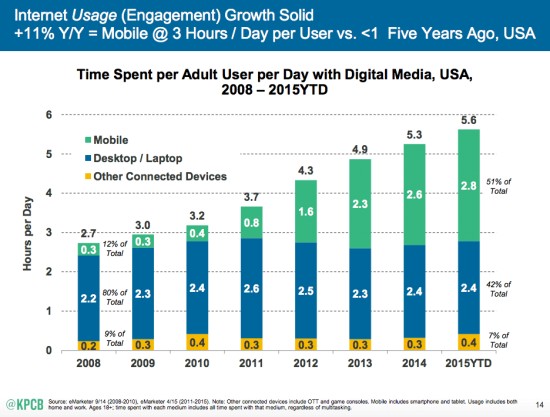


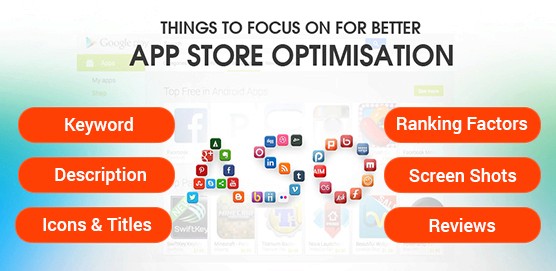
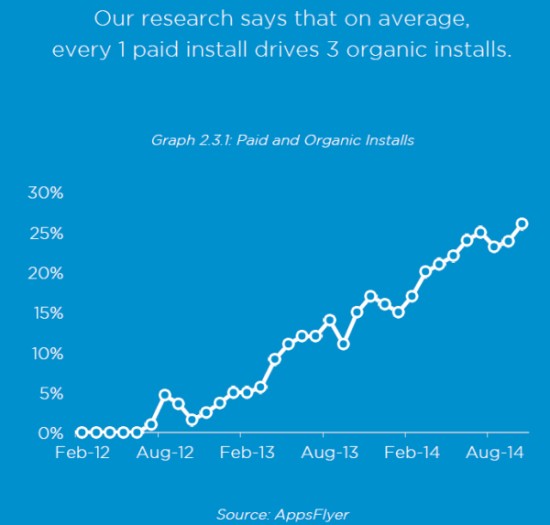


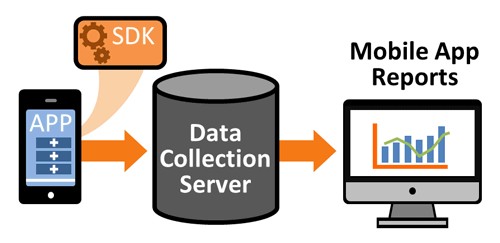
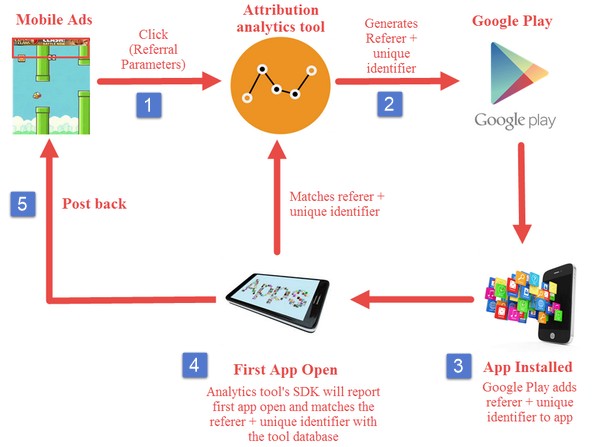
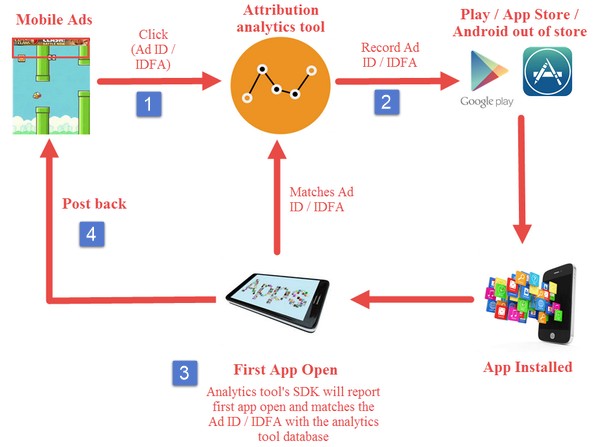

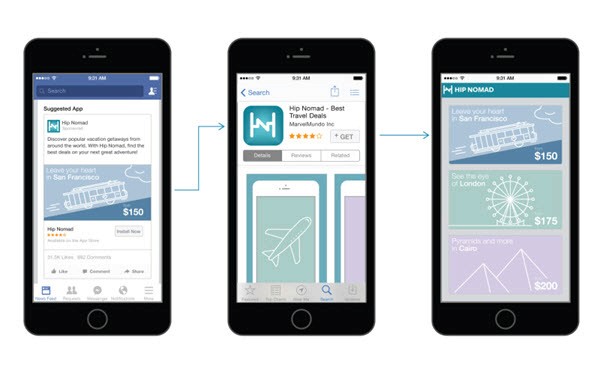
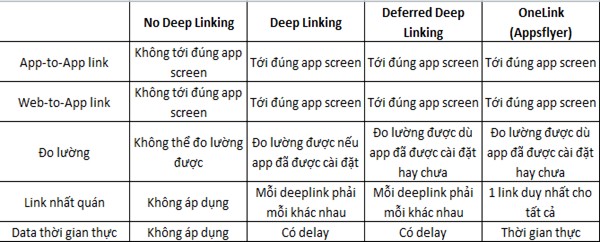
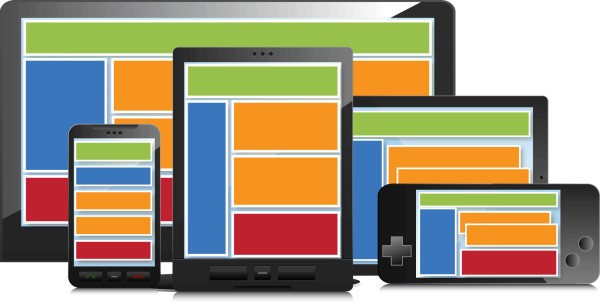







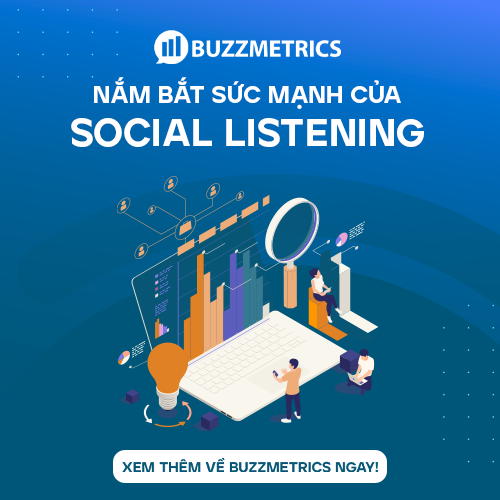
 Vietnamese
Vietnamese English
English